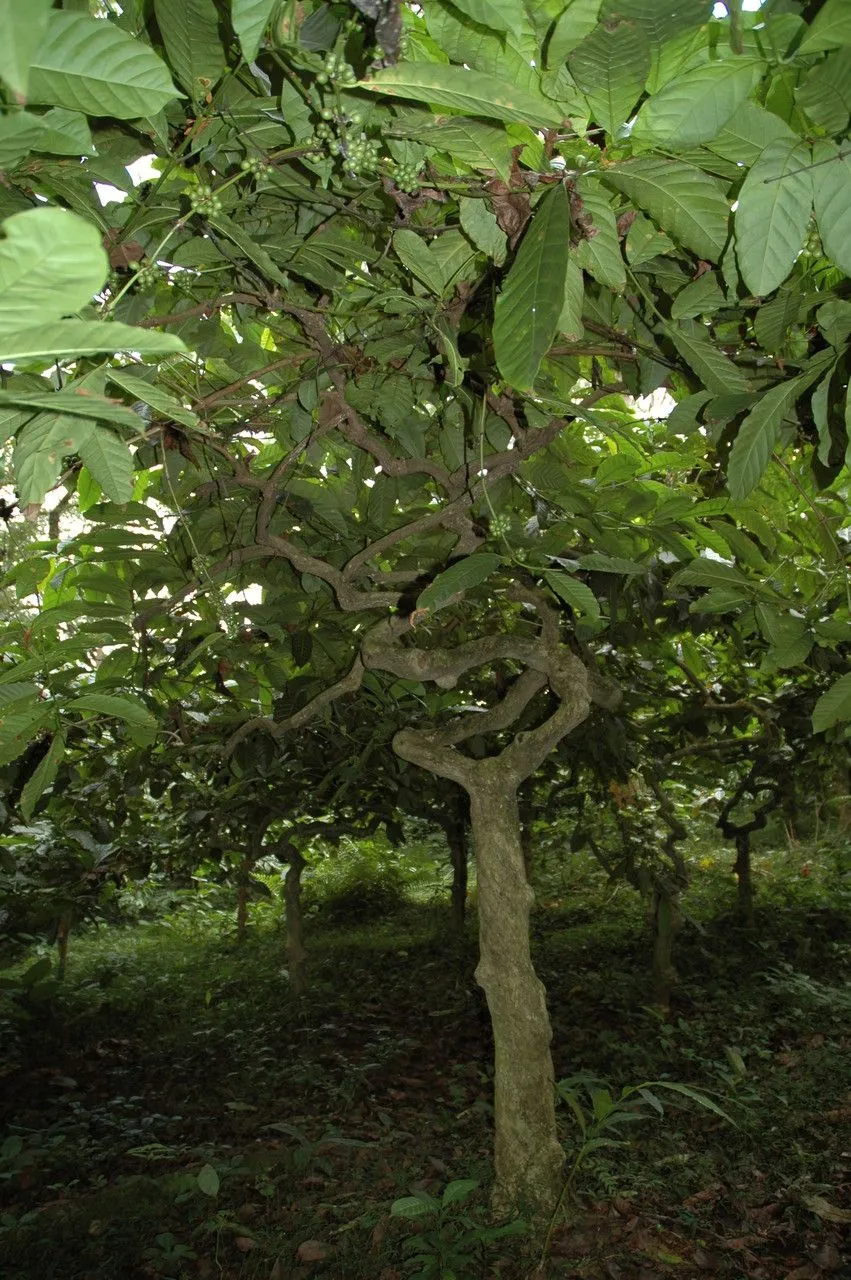
Author: Pierre ex A.Froehner
Bibliography: Notizbl. Bot. Gart. Berlin-Dahlem 1: 237 (1897)
Year: 1897
Status: accepted
Rank: species
Genus: Coffea
Vegetable: False
Observations: W. Trop. Africa to South Sudan and N. Angola
The Congo coffeetree, scientifically known as Coffea canephora, is a remarkable species within the diverse Rubiaceae family. First described and cataloged in the botanical literature “Notizbl. Bot. Gart. Berlin-Dahlem” in 1897 by Pierre and A. Froehner, this tree has since garnered attention for its distinctive characteristics and economic significance.
Native to the tropical regions of Western Africa, stretching from West Tropical Africa to South Sudan and Northern Angola, Coffea canephora thrives in hot, humid environments. The Congo coffeetree is particularly well-adapted to these equatorial climates, where it flourishes under the canopy of dense forests and along riverbanks, benefiting from the rich, well-drained soils and ample rainfall.
Botanically, the Congo coffeetree is resilient and robust, often characterized by its large, elliptical leaves which are dark green and glossy. This species can grow into a sizeable tree, exhibiting a bushy form which provides a significant advantage in natural habitats as it competes for light and resources. The deep green foliage forms a dense canopy, playing a crucial role in local ecosystems by offering shelter and sustenance to various wildlife species.
One of the most notable aspects of Coffea canephora is its contribution to the global coffee industry. It is better known in commercial contexts as Robusta coffee, famed for its hardy nature and resistance to pests and diseases, unlike its more delicate cousin, Arabica coffee. The beans from Coffea canephora are smaller, rounder, and contain higher levels of caffeine and chlorogenic acids, which contribute to a stronger, more bitter flavor profile. These qualities make Robusta coffee a preferred choice for espresso blends and instant coffee production, as it contributes to a richer crema and greater body in coffee beverages.
Coffea canephora plays a vital role in the livelihoods of farmers across its native range. Cultivation of this species not only supports the local economies but also fosters agricultural diversity and sustainability. Traditional farming methods coexist with modern practices to yield high-quality coffee beans that are traded on international markets, ensuring that this venerable species continues to be appreciated worldwide.
In conclusion, the Congo coffeetree or Coffea canephora stands as a botanical and economic cornerstone, deeply rooted in the regions of Western Tropical Africa to Northern Angola and South Sudan. Its resilient nature and significant contribution to the coffee industry underscore the importance of preserving and understanding this valuable plant species.
Eng: congo coffeetree, robusta coffee
Deu: robustakaffeebaum, robustakaffeestrauch
Spa: cafeto robusto
Por: café, café-conilon, café-robusta, cafeiro
Fra: caféier robuste, café robusta
En: Congo coffeetree, Robusta coffee
Fr: Caféier robuste, Café robusta
De: Robustakaffeebaum, Robustakaffeestrauch
Pt: Café, Café-conilon, Café-robusta, Cafeiro
Es: Cafeto robusto
Taken May 9, 2020 by Jacob Nulik (cc-by-sa)
Taken Oct 5, 2016 by Luciano Caldas Felipe (cc-by-sa)
Taken Oct 5, 2016 by Luciano Caldas Felipe (cc-by-sa)
Taken Nov 20, 2004 by Daniel Barthelemy (cc-by-sa)
Taken Jan 1, 2000 by Daniel Barthelemy (cc-by-nc)
Taken Nov 20, 2004 by Daniel Barthelemy (cc-by-sa)
Taken Aug 10, 2005 by OTS – O. Vargas (cc-by-nc-sa)
Taken Aug 10, 2005 by OTS – O. Vargas (cc-by-nc-sa)
Taken Jan 29, 2022 by Montoya Grisales Montoya Grisales (cc-by-sa)
Taken Oct 6, 2022 by GHINA SALWA SALSABILA (cc-by-sa)
Taken Apr 17, 2019 by OTS – R. Aguilar (cc-by-nc-sa)
Taken Mar 19, 2022 by Davi Pierini (cc-by-sa)
Taken May 4, 2022 by Chiara D’Arco (cc-by-sa)
Taken Apr 17, 2019 by OTS – R. Aguilar (cc-by-nc-sa)
Taken Apr 17, 2019 by OTS – R. Aguilar (cc-by-nc-sa)
Taken Apr 17, 2019 by OTS – R. Aguilar (cc-by-nc-sa)
Taken Apr 17, 2019 by OTS – R. Aguilar (cc-by-nc-sa)
© copyright of the Board of Trustees of the Royal Botanic Gardens, Kew.
© copyright of the Board of Trustees of the Royal Botanic Gardens, Kew.
© copyright of the Board of Trustees of the Royal Botanic Gardens, Kew.
Family: Myrtaceae Author: (F.Muell.) K.D.Hill & L.A.S.Johnson Bibliography: Telopea 6: 402 (1995) Year: 1995 Status:…
Family: Sapindaceae Author: Koidz. Bibliography: J. Coll. Sci. Imp. Univ. Tokyo 32(1): 38 (1911) Year:…
Family: Asteraceae Author: A.Gray Bibliography: Pacif. Railr. Rep.: 107 (1857) Year: 1857 Status: accepted Rank:…
Family: Fabaceae Author: Medik. Bibliography: Vorles. Churpfälz. Phys.-Ökon. Ges. 2: 398 (1787) Year: 1787 Status:…
Family: Aspleniaceae Author: (Cav.) Alston Bibliography: Bull. Misc. Inform. Kew 1932: 309 (1932) Year: 1932…
Family: Aspleniaceae Author: (Sw.) R.P.St.John Bibliography: Ferns S.E. States: 241 (1938) Year: 1938 Status: accepted…